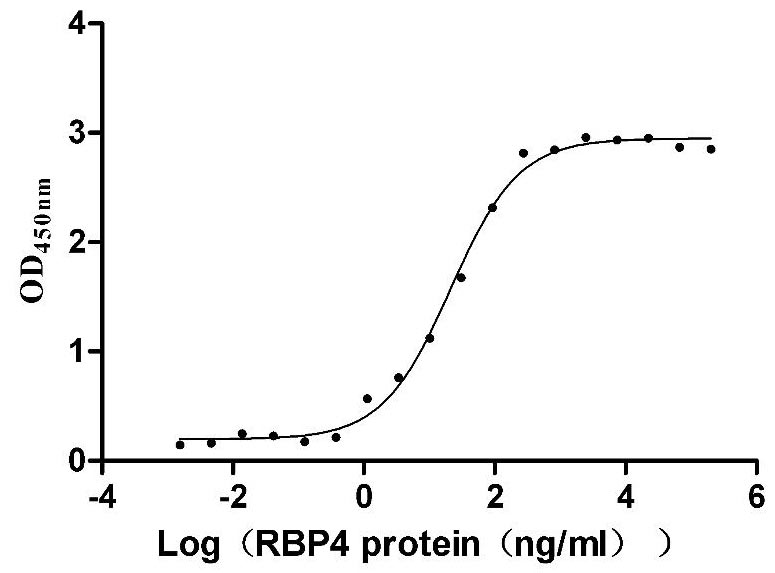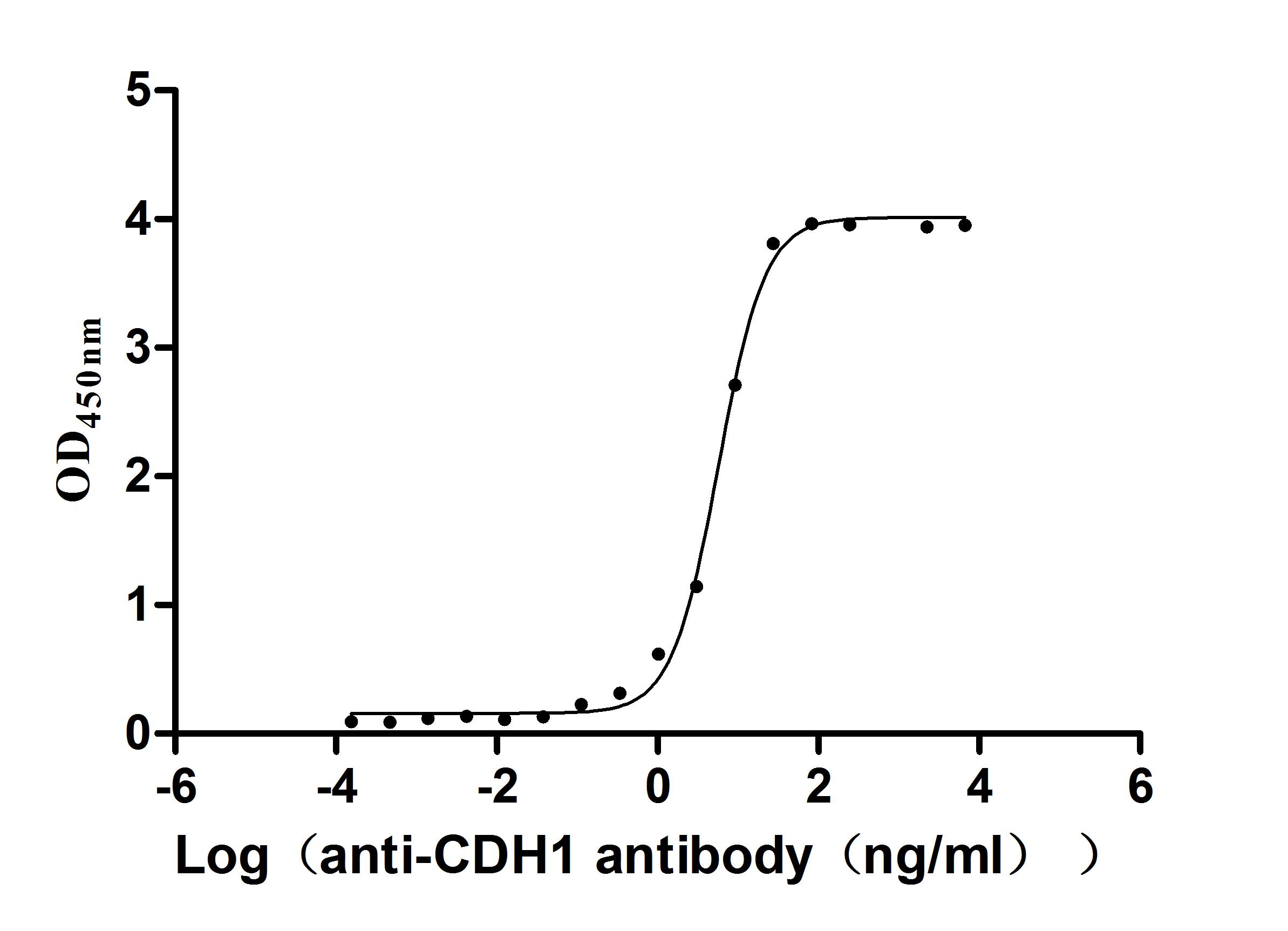Recombinant Mouse Adiponectin receptor protein 1 (Adipor1), partial
-
货号:CSB-YP842016MO1
-
规格:
-
来源:Yeast
-
其他:
-
货号:CSB-EP842016MO1
-
规格:
-
来源:E.coli
-
其他:
-
货号:CSB-EP842016MO1-B
-
规格:
-
来源:E.coli
-
共轭:Avi-tag Biotinylated
E. coli biotin ligase (BirA) is highly specific in covalently attaching biotin to the 15 amino acid AviTag peptide. This recombinant protein was biotinylated in vivo by AviTag-BirA technology, which method is BriA catalyzes amide linkage between the biotin and the specific lysine of the AviTag.
-
其他:
-
货号:CSB-BP842016MO1
-
规格:
-
来源:Baculovirus
-
其他:
-
货号:CSB-MP842016MO1
-
规格:
-
来源:Mammalian cell
-
其他:
产品详情
-
纯度:>85% (SDS-PAGE)
-
基因名:
-
Uniprot No.:
-
别名:Adipor1; Parq1; Adiponectin receptor protein 1; Progestin and adipoQ receptor family member 1; Progestin and adipoQ receptor family member I
-
种属:Mus musculus (Mouse)
-
蛋白长度:Partial
-
蛋白标签:Tag type will be determined during the manufacturing process.
The tag type will be determined during production process. If you have specified tag type, please tell us and we will develop the specified tag preferentially. -
产品提供形式:Lyophilized powder
Note: We will preferentially ship the format that we have in stock, however, if you have any special requirement for the format, please remark your requirement when placing the order, we will prepare according to your demand. -
复溶:We recommend that this vial be briefly centrifuged prior to opening to bring the contents to the bottom. Please reconstitute protein in deionized sterile water to a concentration of 0.1-1.0 mg/mL.We recommend to add 5-50% of glycerol (final concentration) and aliquot for long-term storage at -20℃/-80℃. Our default final concentration of glycerol is 50%. Customers could use it as reference.
-
储存条件:Store at -20°C/-80°C upon receipt, aliquoting is necessary for mutiple use. Avoid repeated freeze-thaw cycles.
-
保质期:The shelf life is related to many factors, storage state, buffer ingredients, storage temperature and the stability of the protein itself.
Generally, the shelf life of liquid form is 6 months at -20°C/-80°C. The shelf life of lyophilized form is 12 months at -20°C/-80°C. -
货期:Delivery time may differ from different purchasing way or location, please kindly consult your local distributors for specific delivery time.Note: All of our proteins are default shipped with normal blue ice packs, if you request to ship with dry ice, please communicate with us in advance and extra fees will be charged.
-
注意事项:Repeated freezing and thawing is not recommended. Store working aliquots at 4°C for up to one week.
-
Datasheet :Please contact us to get it.
相关产品
靶点详情
-
功能:Receptor for ADIPOQ, an essential hormone secreted by adipocytes that regulates glucose and lipid metabolism. Required for normal glucose and fat homeostasis and for maintaining a normal body weight. ADIPOQ-binding activates a signaling cascade that leads to increased AMPK activity, and ultimately to increased fatty acid oxidation, increased glucose uptake and decreased gluconeogenesis. Has high affinity for globular adiponectin and low affinity for full-length adiponectin.
-
基因功能参考文献:
- miR-323-3p appears to be a crucial diabetes factor that mediates its functions by inhibiting the AdipoR1/AMPK/SIRT-1 signaling pathway. PMID: 29512400
- although the physiological levels of adiponectin are sufficient to activate AMPK and Akt when AdipoR1 is overexpressed in beta-cells, yet adiponectin cannot protect beta-cells in Akita mice from ER stress-induced destruction PMID: 29304075
- Immunofluorescence indicated that GPRC6A and adiponectin receptor 1 were co-localized in mouse muscle tissues. The present finding suggested adiponectin receptor 1 can mediate the improvement of glucose metabolism by osteocalcin in ovariectomized mice PMID: 29194451
- adiponectin maintains intestinal homeostasis and protects against murine colitis through interactions with its receptor AdipoR1 and by modulating adaptive immunity and STAT3 signaling PMID: 28258220
- Based on these findings, this study showed that CTRP9 might induce mitochondrial biogenesis and protect high glucose-induced endothelial oxidative damage via AdipoR1-SIRT1-PGC-1alpha signaling pathway. PMID: 27349872
- High salt is an important suppressor of cardioprotective APN and AdipoR1 in cardiac myocytes. PMID: 28051329
- AdipoR1, not AdipoR2, was first identified as a receptor of CTRP6 during the process of mitotic clonal expansion. Collectively, we suggest that CTRP6 mediates the ectopic lipogenesis through AdipoR1/Erk/PPARgamma signaling pathway in myoblasts. PMID: 27125977
- The results demonstrated a dynamic dysfunction of APN/AdipoR1 axis accompanying progression of diabetes mellitus in mice with cerebral ischemia. PMID: 26611106
- physiologic adiponectin levels enhance the vasorelaxative response to acetylcholine by inducing nitric oxide production through AdipoR1/Cav-1 mediated signaling. PMID: 27023866
- AdipoR1 is expressed on adipose tissue-resident Tregs, mainly Helios(+) Tregs, and this expression is dependent on weight and fat accumulation. This data proposes a new mechanism through which weight gain might alter immunoregulation. PMID: 26900653
- Adiponectin directly acts on murine dermal gammadelta-T cells to suppress IL-17 synthesis via AdipoR1. PMID: 26173479
- At high glucose concentrations in vitro, AdipoR1 regulated the survival of neural stem cells through the p53/p21 pathway and the proliferation- and differentiation-related factors of neural stem cells via TLX. PMID: 26247729
- Electroacupuncture induces protective effects against cerebral ischemia through AdipoR1-mediated phosphorylation of GSK-3Beta. PMID: 24915968
- lack of AdipoR1 impairs myocardial mitochondrial function and coupling, suggesting that impaired AdipoR1 signaling may contribute to mitochondrial dysfunction and mitochondrial uncoupling in Type 2 diabetic hearts. PMID: 25982881
- AdipoR1 overexpression in retinal pigment epithelium cells enhances docosahexaenoic acid uptake, whereas AdipoR1 silencing has the opposite effect. PMID: 25736573
- AdipoR1 as a Potential Target for Reversing Diabetes-Induced Osteopenia. PMID: 25633418
- CTRP9 protects against acute cardiac damage in response to pathological stimuli by suppressing inflammatory reactions through AdipoR1/AMPK-dependent mechanisms. PMID: 25870106
- Post-MI AdipoR1 phosphorylation positively correlated with the expression level of GRK2. AdipoR1 is phosphorylated on SER-7, Thr-24, and Thr-53 and desensitized by GRK2 in failing cardiomyocytes, contributing to post-MI remodeling and HF progression. PMID: 25696921
- Data (including data from studies in transgenic mice) suggest that AdipoR1 plays roles in cardiac hypertrophy/lipid accumulation in obesity via regulation of gene expression of proteins involved in oxidative stress and autophagy in heart ventricles. PMID: 24679155
- Obesity worsens the outcome of experimental colitis and suggest an important role for AdipoR1 for the fat-intestinal axis in the regulation of inflammation during colitis. PMID: 25591865
- pathscan analysis and real-time PCR analysis suggest AdipoR1 regulates osteoblast differentiation through GSK-3 beta and beta-Catenin signaling PMID: 24713193
- Its transgene prevents development of diet-induced weight gain, hepatosteatosis and insulin resistance. PMID: 24172199
- these data suggest that AdipoR1 protein levels are regulated by so far uncharacterized class I PDZ proteins PMID: 23860432
- The AdipoR1 modified macrophages provide unique interactions with the residented tissues/cells, suggesting a novel role of macrophage adiponectin receptor in improving metabolic disorders in vivo. PMID: 23510830
- Data suggest that adiponectin attenuates proinflammatory cytokine expression and inhibits NFkappaB activation in Leydig cells; these actions appear to be dependent on AMP-activated protein kinase signaling and adiponectin receptor 1 signaling. PMID: 23773620
- Adiponectin and AdipoR1 may play an important role in the evolvement of type 1 diabetic retinopathy. PMID: 23174569
- This study demonistrated that AdipoR1 is expressed on warm sensitive neurons of the hypothalamic preoptic area and contribute to central hyperthermic effects of adiponectin. PMID: 22000082
- investigation of expression and localization of Adipor1 & Adipor2 during embryo development PMID: 20663797
- Pioglitazone inhibits aortic atherosclerosis in ApoE-/- mice, and these effects are correlated with increased plasma adiponectin level and the expression of AdipoR1 mRNA in vessels. PMID: 19377625
- adiponectin induces extracellular Ca(2+) influx by AdipoR1, which was necessary for subsequent activation of CaMKKbeta, AMPK and SIRT1, increased expression and decreased acetylation of PGC-1alpha, and increased mitochondria in myocytes PMID: 20357764
- Expressed in islets, muscle and liver; expression in mouse islets related to dietary fat. PMID: 15358228
- AdipoR1 and AdipoR2 have differential but overlapping etxpression profiles during mouse development PMID: 15939384
- APPL1 interacts with adiponectin receptors in mammalian cells and the interaction is stimulated by adiponectin. PMID: 16622416
- Pravastatin reversed the reduction of AdipoR1 expression in postinfarction mouse myocardium. PMID: 17906114
- adiponectin stimulates the proliferation, differentiation, and mineralization of osteoblasts via the AdipoR1 and AMP kinase signaling pathways in autocrine and/or paracrine fashions. PMID: 18047638
- These data suggest that a repressive nuclear inhibitory protein element is involved in the negative regulation of AdipoR1 promoter by insulin. PMID: 18789331
- AdipoR1 function in the olfactory epithelium seems to be directly linked to the nutritional status of the body, suggesting a potential modulatory role for AdipoR1 in the adjustment of the olfactory system to energy balance requirements. PMID: 18791742
- Gene expression of AdipoR1 is significantly lower in the liver ob obese mice. PMID: 19062045
显示更多
收起更多
-
亚细胞定位:Cell membrane; Multi-pass membrane protein.
-
蛋白家族:ADIPOR family
-
组织特异性:Detected in brain and quadriceps muscle (at protein level). Widely expressed. Expressed in heart, kidney, liver, lung, skeletal muscle, white adipose tissue, brown adipose tissue, aorta and spleen. Weakly expressed in brain and testis.
-
数据库链接:
KEGG: mmu:72674
STRING: 10090.ENSMUSP00000027727
UniGene: Mm.259976
Most popular with customers
-
Recombinant Mouse Transthyretin (Ttr) (Active)
Express system: Mammalian cell
Species: Mus musculus (Mouse)
-
Recombinant Human Interleukin-2 receptor subunit alpha (IL2RA), partial (Active)
Express system: Mammalian cell
Species: Homo sapiens (Human)
-
Recombinant Human Interleukin-2 (IL2) (Active)
Express system: Mammalian cell
Species: Homo sapiens (Human)
-
Recombinant Human CD70 antigen (CD70), partial (Active)
Express system: Mammalian cell
Species: Homo sapiens (Human)
-
Recombinant Human Cadherin-1(CDH1),partial (Active)
Express system: Mammalian cell
Species: Homo sapiens (Human)

















